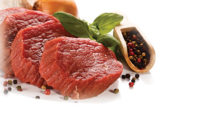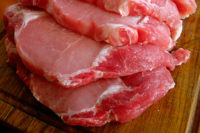Before the COVID-19 outbreak, consumers were purchasing a variety of pre-portioned or portion-controlled meat and poultry products. A shift in lifestyle changes because of the pandemic caused the total poultry and meat portion size category (0- to 6-ounce sizes) to drop 3.8 percent to approximately $654.2 million for the latest 52 weeks ending Feb. 21 in total U.S. multi-outlets, according to IRI Inc., Chicago.
“Category declines could have adversely been impacted by the COVID-19 pandemic with fewer people eating or snacking away from home, as overall distribution levels remained consistent over the past 52 weeks,” says Rick Butler, IRI’s client insights consultant. “Trends could reverse as schools reopen and people return to work.”
One of the largest drivers that IRI has tracked in nearly every product category storewide is the drop in consumers’ mobility. Mobility reports from Google and Apple (which track mobility through consumers’ phones) whether national, statewide, regionally or locally all report a large reduction in mobility, says Chris DuBois, IRI’s senior vice president. That shift in mobility explains about half of all the change in supermarket sales, he says. As people return to their offices, more schools open up and vacationing returns, DuBois believes mobility will return to being a natural driver of consumers’ purchases and help necessitate portion-sized protein lunches and snacks again.
Still, this year, the 2.1- to 4-ounce portion size seems to be the “sweet spot” within the category, Butler says. The 2.1- to 4-ounce segment, which represents 76.3 percent of the total category sales, saw less decline (-2.1 percent) than the other portion size segments and dipped to $499.3 million. This is partly due to the fact that Lunchables, which makes up 46 percent of the 2.1- to 4-ounce segment, grew 3.3 percent for the 52 weeks ending Feb. 21, IRI reports. Oscar Mayer also grew 1.6 percent during the same time period.
Older Millennials and Gen Xers are the primary drivers of sales for these snack-size options, Butler adds. They purchase almost 70 percent of the 2.1- to 4-ounce portion segment’s sales. Additionally, household penetration for portion-controlled meat and snacks is 23 percent for year ending Feb. 21, with a repeat rate of 65 percent, which is remarkably high, Butler says.
Producing Proper Portion Sizes

Meat snack sales have grown tremendously in recent years, and charcuterie snack kits have become popular items. Photo courtesy of Fratelli Beretta.
Meat snack sales have grown tremendously in recent years, and charcuterie snack kits have become popular items. Photo courtesy of Fratelli Beretta.
The recently released Dietary Guidelines for Americans, 2020-2025, jointly published by the U.S. Departments of Agriculture and Health and Human Services, states portion sizes can be reduced by manufacturers and restaurant operators to help people make choices that better fit within their calorie needs. Even from the youngest ages, almost all Americans need to shift to more healthful food and beverage choices and consume smaller portions to achieve a healthy dietary pattern within an appropriate number of calories, the guidelines show.
“One of the biggest challenges we all have when it comes to portion sizes is being able to accurately visualize a recommended size,” says Ali Webster, director of research and nutrition communications at the International Food Information Council, in Washington, D.C. “Our eyes have been trained to anticipate a large steak or piece of chicken as one serving when in reality that one portion of protein could contain several servings. Providing people with helpful tips to navigate dining out, including benefits of choosing smaller portions along with images and examples of proper protein portion sizes, could help us re-train our mindset and expectations to allow smaller portions to become our new normal.”
U.S. Multi-Outlet Latest 52wks ending 2/21/21
| Product | Dollar Sales | Dollar Sales Year Ago | Dollar Sales % Change vs YA |
| COOKING MEAL KITS | $161,387,551 | $99,106,992 | 62.8% |
| TYSON COOKING MEAL KITS | $78,630,263 | $57,472,407 | 36.8% |
| PRIVATE LABEL COOKING MEAL KITS | $43,914,535 | $27,189,155 | 61.5% |
| GIOVANNI RANA RANA COOKING MEAL KITS | $26,098,352 | $4,070,348 | 541.2% |
| HELLOFRESH COOKING MEAL KITS | $3,770,607 | $2,308,217 | 63.4% |
| LOCAL CRATE COOKING MEAL KITS | $2,315,728 | $1,391,357 | 66.4% |
| DON PANCHO COOKING MEAL KITS | $1,667,567 | ||
| PLATED COOKING MEAL KITS | $1,585,729 | $1,842,694 | -13.9% |
| TODAYS KITCHEN COOKING MEAL KITS | $655,909 | $904,899 | -27.5% |
| DEL REAL COOKING MEAL KITS | $628,687 | $346,242 | 81.6% |
| TAYLOR COOKING MEAL KITS | $575,320 |
Source - IRI Integrated Fresh Syndicated point of sale data 52wks ending 2/21/21
Snacking Up
One of the key trends and opportunities in the meat and poultry space is a shift to smaller, portable and snack-size formats, says Kaitlin Kamp, food and drink analyst at Mintel International, in Chicago. “These have become increasingly popular with the rise of protein’s importance in a healthy diet,” she explains.
For example, 20 percent of U.S. consumers are eating animal-based proteins more often than last year and are doing so for their health, Mintel finds. Additionally, 46 percent are eating more animal protein than last year to eat healthier, and 42 percent are doing so to stay full longer, the research firm finds.
“These health goals have directly translated to snack time,” Kamp explains. “Twenty-nine percent are eating animal protein more often than last year because they are snacking on it more.”
For example, Farm Rich Time Outs and Chicken of the Sea Infusions both combine smaller portion sizes with portable packaging to encourage easy on-the-go, high-protein snacking.
“The meat snacks category has also seen significant growth as consumers look for convenient, high-protein snack options,” Kamp says. “Meat snack sales have grown 30 percent since 2014 and are expected to grow another 26 percent by 2024."
Mintel also finds that those aged 18 to 44 are the most likely to eat animal protein more often because they snack on it more. Younger consumers and parents are the most likely to consume meat snacks as a convenient and tasty way to increase their protein intake.
Consumers also are expected to continue prioritizing their health during and after the COVID-19 pandemic, benefitting products that help consumers meet their protein goals, Kamp says. According to Mintel’s global COVID-19 tracker (Sept. 17-25, 2020), 42 percent of consumers are placing a higher priority on eating healthy because of COVID-19.
Lunch Kit Category and Segment Breakdown (0.0 - 6.0oz)
| Major Brand | Dollar Sales | Dollar Sales Year Ago | Dollar Sales % Change vs YA |
| All Major Brands | $654,206,474 | $680,071,736 | -3.8% |
| LUNCHABLES | $270,886,236 | $264,877,782 | 2.3% |
| ARMOUR LUNCH MAKERS | $107,141,241 | $113,041,169 | -5.2% |
| P3 | $79,882,870 | $91,948,648 | -13.1% |
| OSCAR MAYER | $49,312,673 | $48,527,242 | 1.6% |
| PRIVATE LABEL | $44,642,146 | $56,267,042 | -20.7% |
Source - IRI Integrated Fresh Syndicated point of sale data 52wks ending 2/21/21
Lunch Kit Category and Segment Breakdown (0.0 - 6.0oz)
| Major Brand | Dollar Sales | Dollar Sales Year Ago | Dollar Sales % Change vs YA |
| All Major Brands | $56,446,553 | $63,352,580 | -10.9% |
| P3 | $47,874,449 | $49,365,680 | -3.0% |
| HORMEL NATURAL CHOICE | $6,079,720 | $11,631,109 | -47.7% |
| ALL CREMINELLI FINE MEATS LLC | $1,575,743 | $1,451,761 | 8.5% |
| PRIVATE LABEL | $412,688 | $488,737 | -15.6% |
| OLLI SALUMERIA | $335,924 | $237,871 | 41.2% |
Source - IRI Integrated Fresh Syndicated point of sale data 52wks ending 2/21/21
Lunch Kit Category and Segment Breakdown (2.1-4.0oz)
| Major Brand | Dollar Sales | Dollar Sales Year Ago | Dollar Sales % Change vs YA |
| All Major Brands | $499,345,256 | $510,088,061 | -2.1% |
| LUNCHABLES | $230,806,371 | $223,371,413 | 3.3% |
| ARMOUR LUNCH MAKERS | $107,141,241 | $113,041,169 | -5.2% |
| OSCAR MAYER | $49,312,673 | $48,527,240 | 1.6% |
| PRIVATE LABEL | $29,823,491 | $36,972,117 | -19.3% |
| P3 | $28,674,068 | $35,744,565 | -19.8% |
Source - IRI Integrated Fresh Syndicated point of sale data 52wks ending 2/21/21
Lunch Kit Category and Segment Breakdown (4.01-6.0oz)
| Major Brand | Dollar Sales | Dollar Sales Year Ago | Dollar Sales % Change vs YA |
| All Major Brands | $98,414,665 | $106,631,095 | -7.7% |
| LUNCHABLES | $40,079,865 | $41,506,369 | -3.4% |
| PRIVATE LABEL | $14,405,968 | $18,806,188 | -23.4% |
| DELI EXPRESS | $10,281,363 | $11,296,913 | -9.0% |
| TAYLOR FARMS | $6,794,902 | $3,136,638 | 116.6% |
| P3 | $3,334,352 | $6,838,402 | -51.2% |
Source - IRI Integrated Fresh Syndicated point of sale data 52wks ending 2/21/21
“While portability has taken a backseat during the pandemic, these smaller snack-sized products still appeal for their convenience,” Kamp says. “Post-pandemic, portability will once again become a priority, and these types of products will appeal not only as an easy and flavorful way to increase protein intake, but also as a good way to do so on the go.”
IRI also finds that Americans are moving away from traditional meals and toward more frequent snacking. On the average, U.S. consumers are eating 2.6 snacks a day, with 42 percent reporting they consume more than three per day, IRI finds. Another 44 percent of consumers said they often ate snacks instead of meals at home and at work, the research firm reports.
“When you are eating that many snacks, you would think you’d be mindful of the health and wellness attributes associated with those products as well,” Butler says.
As far as emerging categories in portion-controlled snack products, charcuterie-grade snacking seems to be an emerging trend as seen with growth in products from Creminelli Fine Meats, Olli Salumeria and Fiorucci. Slightly more expensive than a traditional protein snack pack, charcuterie-grade snack trays typically feature artisan meats and cheeses along with items such as artisan crackers, breadsticks or dried fruits such as cherries.
“I look at that as an indulgent snack,” Butler says.
Charcuterie-grade snacks fit in perfectly with one of the largest trends IRI has tracked during the last year: premiumization.
“All across the store, we’ve seen a big expansion, and people are buying a lot of premium products,” DuBois explains. “You wonder how this happens in a recession, but the fact is a lot of people kept their jobs, so that part is good. But nobody is spending the same kind of money that they were, so there is enormous amount of savings. So when people are at home working, they are willing to indulge in a better meal, or they will buy a better cut of meat, or they will put a different meal on the table and explore. Charcuterie actually fits perfectly into that idea of premiumization.”
With the current premiumization trend, what is unusual about this trend is it can be seen across all demographics as well. IRI also finds that the shift to premium brands even goes across all household incomes, and even low-income households report making small indulgent purchases.
“It’s about making the experience better whether it’s the meal or whatever they are going for,” Butler says.
Cooking at Home

Another bright spot in the portioned category is prepackaged meal kits, which jumped 62.8 percent in dollar sales to nearly $161.4 million for the year ending Feb. 21, IRI reports. The top three brands — Tyson, private label and Rana — comprise 92.1 percent of the total meal kit category. Older Millennials and Gen Xers also make up 56 percent of meal kit sales, with the category having household penetration of 5.7 percent. The average spend is about $25 per year on the meal kit category, which is not surprising with some meal kits costing $11 or $12, Butler says. “Given the convenience meal kits offer consumers, growth trends are expected to continue, and retailers and manufacturers are always trying to introduce new varieties,” he adds.
Frozen processed poultry (including value-added) also experienced exceptional growth during the pandemic as supply-chain issues affected fresh poultry, which drove more consumers to frozen, Butler says. As a result, frozen meat, poultry and seafood was up 28.1 percent in dollar sales percent change vs. a year ago for the 52 weeks ending Feb. 21, IRI reports. Frozen meat and frozen poultry grew 20.1 percent and 14.9 percent respectively, with frozen processed poultry up 25.2 percent. Sales of frozen meals also rose 15.2 percent. The latest 52 weeks saw household penetration increase 1.4 points and average spending grow 32 percent across the total frozen meat, poultry and seafood category.
The increased spending also resulted from increased trips and dollars per trip, Butler says.
“That’s a lot of new households coming into the franchise that may not necessarily be new to meat or poultry or even seafood consumption, but they may have been sourcing it out of the home, and now it’s being reflected in retail purchases,” he explains.
Moving through this year, IRI expects continued growth of frozen meat, poultry and seafood sales thanks to its convenience and portion flexibility, but probably not at this current sales rate.
Sizing for 2021
While early in the pandemic many shoppers started out indulging in traditional and comfort food choices, January kicked off with New Year’s resolutions for 64 percent of shoppers. More than one third (35 percent) aim to eat healthier in general, 35 percent want to get more exercise and 29 percent plan to save more money, according to the IRI Consumer Network survey conducted in January. For meat and poultry product manufacturers, this means the consumer’s eye is on nutrition as well as price and promotion, Butler says. The good news is that total meat sales grew in the latest period, which is led by increased trip per buyer, dollars per trip and basket size, IRI reports. With many consumers still working exclusively or mostly remotely — and 83 percent of office workers saying they’d like the option to work from home at least once a week, a recent PricewaterhouseCoopers survey found — refrigeration-dependent snacks such as charcuterie packs and deli meats on crackers stand to continue to hold strong appeal, Butler says. Overall, as the American population becomes vaccinated and schools and institutions reopen and more people return to work, Butler thinks the decline in portion-controlled meat and poultry snacks should reverse itself. “Manufacturers are looking at this space very closely and looking at the value of getting into it,” Buter says. “The other question a lot of retailers have is where to merchandise it to maximize exposure and sales.”
Producing Proper Portion Sizes
The recently released Dietary Guidelines for Americans, 2020-2025, jointly published by the U.S. Departments of Agriculture and Health and Human Services, states portion sizes can be reduced by manufacturers and restaurant operators to help people make choices that better fit within their calorie needs. Even from the youngest ages, almost all Americans need to shift to more healthful food and beverage choices and consume smaller portions to achieve a healthy dietary pattern within an appropriate number of calories, the guidelines show.
“One of the biggest challenges we all have when it comes to portion sizes is being able to accurately visualize a recommended size,” says Ali Webster, director of research and nutrition communications at the International Food Information Council, in Washington, D.C. “Our eyes have been trained to anticipate a large steak or piece of chicken as one serving when in reality that one portion of protein could contain several servings. Providing people with helpful tips to navigate dining out, including benefits of choosing smaller portions along with images and examples of proper protein portion sizes, could help us re-train our mindset and expectations to allow smaller portions to become our new normal.” NP







